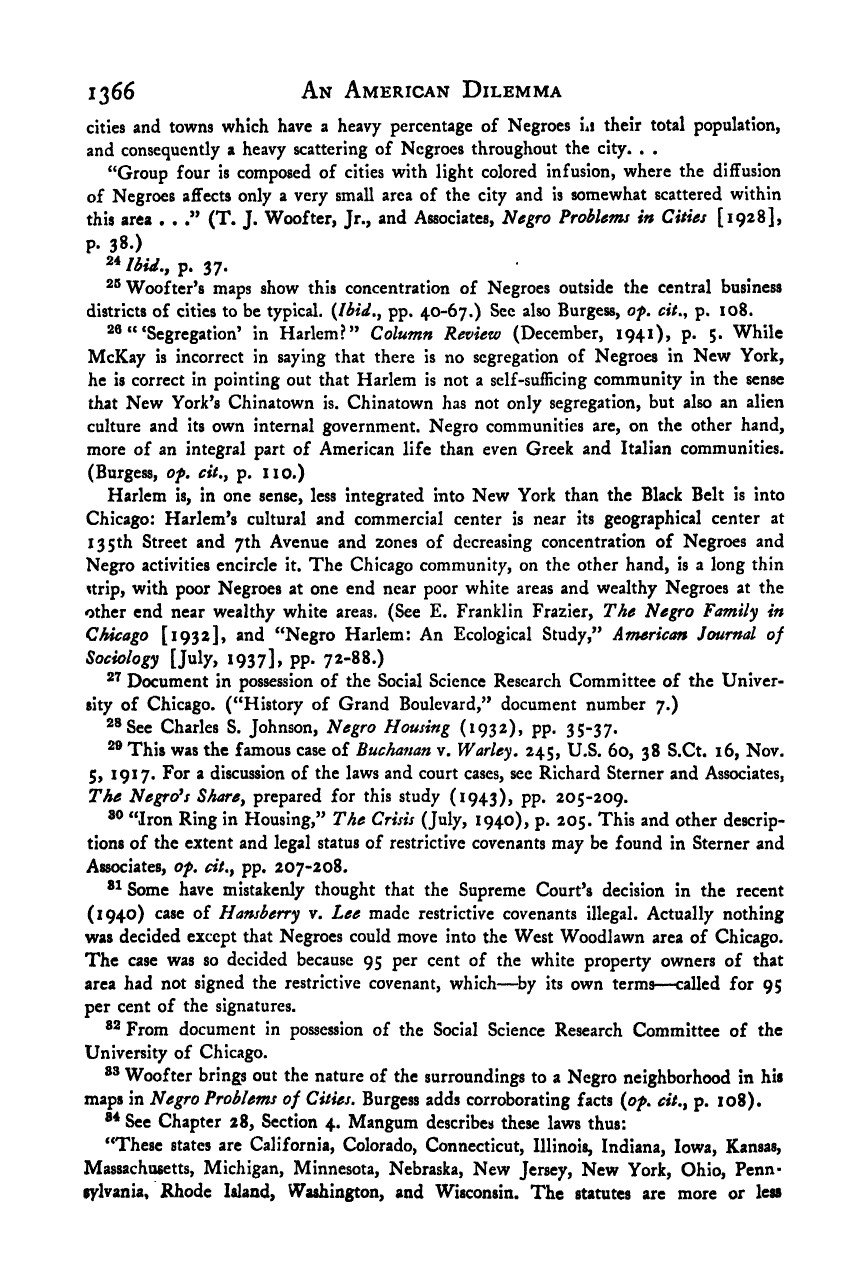Note: Gunnar Myrdal died in 1987, less than 70 years ago. Therefore, this work is protected by copyright, restricting your legal rights to reproduce it. However, you are welcome to view it on screen, as you do now. Read more about copyright.
Full resolution (TIFF) - On this page / på denna sida - Footnotes - Chapter 29

<< prev. page << föreg. sida << >> nästa sida >> next page >>
Below is the raw OCR text
from the above scanned image.
Do you see an error? Proofread the page now!
Här nedan syns maskintolkade texten från faksimilbilden ovan.
Ser du något fel? Korrekturläs sidan nu!
This page has never been proofread. / Denna sida har aldrig korrekturlästs.
1366 An American Dilemma
cities and towns which have a heavy percentage of Negroes iii their total population,
and consequently a heavy scattering of Negroes throughout the city. . .
“Group four is composed of cities with light colored infusion, where the diffusion
of Negroes affects only a very small area of the city and is somewhat scattered within
this area • • (T. J. Woofter, Jr., and Associates, Negro Problems in Cities [1928],
P- 38.)
Ibid.y p. 37.
2® Woofter’s maps show this concentration of Negroes outside the central business
districts of cities to be typical. (Ibid,^ pp. 40-67.) See also Burgess, of, cit,^ p. 108.
2® “ ‘Segregation’ in Harlem?” Column Review (December, 1941), p. 5. While
McKay is incorrect in saying that there Is no segregation of Negroes in New York,
he is correct In pointing out that Harlem is not a self-sufficing community in the sense
that New York’s Chinatown is. Chinatown has not only segregation, but also an alien
culture and its own internal government. Negro communities are, on the other hand,
more of an integral part of American life than even Greek and Italian communities.
(Burgess, of, cit,, p. no.)
Harlem is, in one sense, less integrated into New York than the Black Belt is into
Chicago: Harlem’s cultural and commercial center is near its geographical center at
135th Street and 7th Avenue and zones of decreasing concentration of Negroes and
Negro activities encircle it. The Chicago community, on the other hand, is a long thin
Urip, with poor Negroes at one end near poor white areas and wealthy Negroes at the
other end near wealthy white areas. (See E. Franklin Frazier, Tbe Negro Family in
Chicago [1932], and “Negro Harlem: An Ecological Study,” American Journal of
Sociology [July, 1937 ]. PP- 72-88.)
2*^
Document in possession of the Social Science Research Committee of the Univer-
sity of Chicago. (“History of Grand Boulevard,” document number 7.)
2® See Charles S. Johnson, Negro Housing (1932), pp. 35-37.
2® This was the famous case of Buchanan v. Warley, 245, U.S. 60, 38 S.Ct. 16, Nov.
5, 1917. For a discussion of the laws and court cases, sec Richard Sterner and Associates,
The Negroes Share^ prepared for this study (X943), pp. 205-209.
2® “Iron Ring in Housing,” The Crisis (July, 1940), p. 205. This and other descrip-
tions of the extent and legal status of restrictive covenants may be found in Sterner and
Associates, of, cit,, pp, 207-208.
2^ Some have mistakenly thought that the Supreme Court’s decision in the recent
(1940) case of Hansberry v. Lee made restrictive covenants illegal. Actually nothing
was decided except that Negroes could move into the West Woodlawn area of Chicago.
The case was so decided because 95 per cent of the white property owners of that
area had not signed the restrictive covenant, which—^by its own terms—called for 95
per cent of the signatures.
22 From document in possession of the Social Science Research Committee of the
University of Chicago.
2® Woofter brings out the nature of the surroundings to a Negro neighborhood in his
maps in Negro Problems of Cities, Burgess adds corroborating facts {of, cit,, p. 108).
24 See Chapter 28, Section 4. Mangum describes these laws thus:
‘‘These states are California, Colorado, Connecticut, Illinois, Indiana, Iowa, Kansas,
Massachusetts, Michigan, Minnesota, Nebraska, New Jersey, New York, Ohio, Penn-
sylvania, Rhode Island, Washington, and Wisconsin. The statutes are more or less
<< prev. page << föreg. sida << >> nästa sida >> next page >>